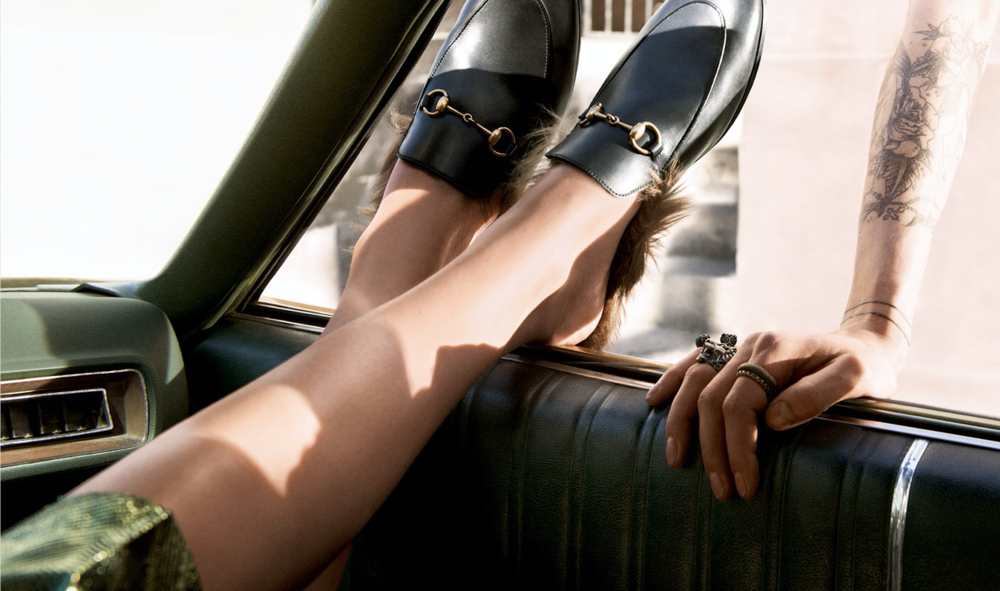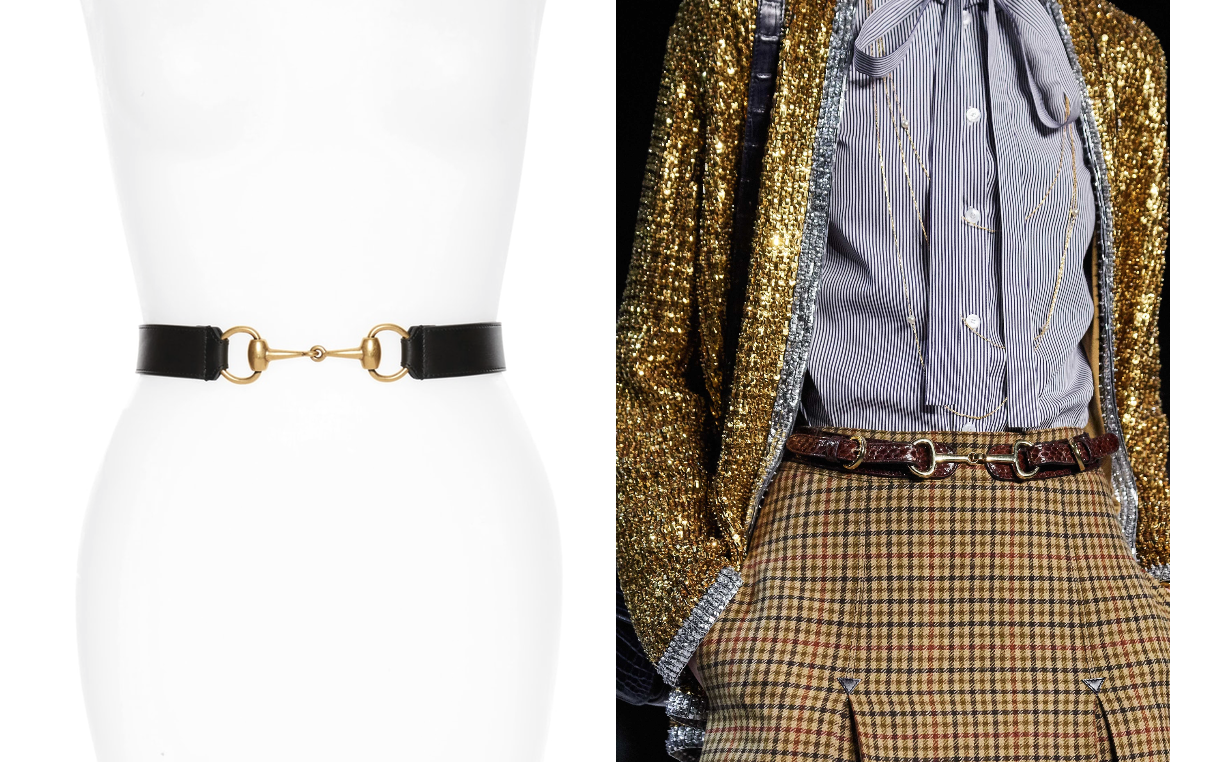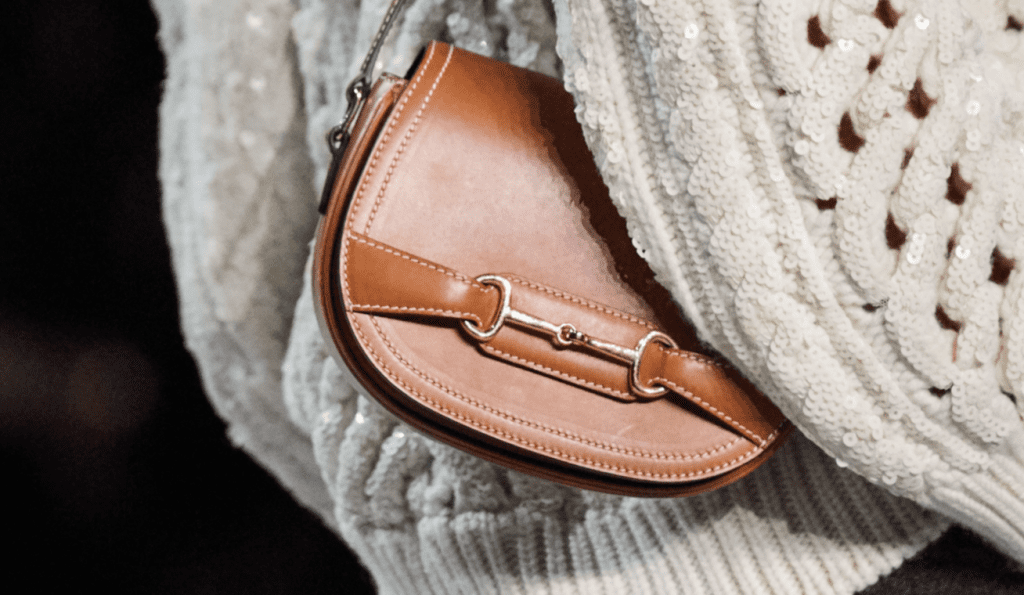It has been almost 20 years since the two most esteemed luxury goods conglomerates in the world have sparred publicly. However, nearly two decades after LVMH and Kering scuffled and skirmished for the right to take control over the then-privately held Gucci (Kering won that high-stakes battle), the offerings from Hedi Slimane’s latest collection for Celine seem to suggest that the since-enduring peace between the two French giants might be dissipating.
Look closely. Among the wares befitted for “the Parisian bourgeoisie,” as Vogue’s Sarah Mower described Slimane’s recent aesthetic shift from his signature Los Angeles-centric rock-n-roll sex doll wares to the equine-inspired, country-home-going womenswear he showed this past week for Fall/Winter 2019, you will see a striking symbol. In the midst of printed scarves, prim pussy bow-tied blouses, tweedy blazers, and over-the-knee boots trimmed with cream-colored shearling, horsebits adorn supple leather shoulder bags and exotic-skinned belts.
Aside from the thematic relevance of the horsebit in a collection imbued with equestrian aesthetics, the Celine archives reveal that Slimane’s hardware-of-choice is a reference to house codes gone-by; Paris-based Celine began using of metal horsebit accents on its accessories, namely, its footwear, beginning in 1972.
Days before Slimane sent a bevy of sunglass-wearing models down the runway in Paris, Alessandro Michele was busy staging the latest iteration of his signature hodge-podge of oh-so-many-things for Gucci in Milan. In the mix of looks crafted from rainbow-hued leathers, metallic-hinted jacquards, vibrant houndstooths, glossy skins, and gold lamé was Michele’s take on a longstanding Gucci staple: the horsebit.
A small gold icon that mimics the classic “D” ring snaffle bit is one of the strongest indicators of source for the nearly 100-year old Gucci brand, and has been ever since the house’s founder Guccio Gucci started using the horsebit on Gucci’s leather goods in the 1930’s. His son and business successor, Aldo Gucci, would pioneer the use of the emblem some 20 years later when he began affixing it to Gucci’s famous loafers, where it remains to this day.
While the horsebit is, in fact, a widely-used equine tool, that fact alone does not preclude Gucci from amassing legal rights. Unlike other forms of intellectual property law, which include novelty and originality requirements, trademark law does not demand that a mark be inherently new in order to be protected. Generally speaking, as long as consumers associate the mark with a single source in connection with the types of goods and services for which it is used, rights can be claimed.
 image: Gucci
image: Gucci
In recent years, horsebit-encrusted Gucci slides and disco-inspired platforms have flooded Gucci’s e-commerce site and those of luxury retailers, such as 24Sèvres, supplementing to its decades-old stable of horsebit leather loafers. All the while, The RealReal and other resale sites are offering up no small number of Gucci horsebit leather tote bags and satchels from seasons come-before.
Soon, Celine’s horsebit-adorned bags and belts could be sitting beside these very goods on some of the exact same websites, demanding the attention – and dollars – of the exact same consumers. From a legal perspective, that might be problematic.
Regardless of whether Celine made use of a horsebit back in the 1970’s, its use lapsed years ago and with it, any trademark rights it may have held, in line with trademark law’s “use it or lose it” motto. Meanwhile, Gucci has been using its horsebit mark continuously for decades, and amassing trademark rights in the symbol in many jurisdictions across the globe, including in France, where Celine is headquartered.
With Gucci’s exclusive rights in mind, could a Gucci v. Celine trademark infringement case be in the making?
In order to wage a successful trademark infringement case against its French rival, Gucci would have to establish a few things, including that Celine is using the horsebit as a trademark – aka to identify the source of its bags and belts – and not merely in a decorative manner. Given the equestrian theme of the collection, Celine could certainly argue that the latter is exactly how it is using the horsebit here. (Decoration, as opposed to source identification, is probably how uses of horsebits by Hermès, Fendi, and Salvatore Ferragamo, among other brands, should be characterized, as well).
 Gucci (left) & Celine (right)
Gucci (left) & Celine (right)
Beyond that, the Italian design house would need to prove that (despite at least a few notable differences in appearance between the two brands’ horsebit designs) consumers are likely to be confused about the source of the Celine bags and belts if they see a horsebit on them. This is arguably much less of a stretch to prove, given that Gucci has been adorning many of its accessories with horsebits for decades, and as a result, consumers have likely come to associate the horsebit design on bags and other leather goods with the Gucci brand.
But … even if Gucci could make its case (and there is no guarantee that it could since Celine’s use is probably decorative), there is a chance that such a lawsuit might never come into fruition due to practical considerations on Gucci’s part. There is a chance, for example, that in response to a trademark infringement case, Celine would challenge the validity of Gucci’s horsebit trademark registrations. This is precisely what happened when Gucci filed suit against Vetir in 2011, alleging that the French apparel and accessories brand was infringing its horsebit mark by making and selling shoes bearing a similar design.
Deciding the case in early 2013, the Tribunale de Grande Instance de Paris held that Gucci’s horsebit mark was a “decorative element” and not sufficiently distinct to serve as a trademark for use on footwear, ultimately dismissing Gucci’s trademark infringement claims and ordering that one of its French trademarks be cancelled.
Should Gucci file suit against Celine, there is a chance that history could repeat itself, the court would find that Gucci’s horsebit mark lacks to necessarily distinctiveness to enjoy trademark protection, and Gucci would be out another registration, which makes for a risky and expensive proposition.
However, it is worth noting that Gucci maintains a valid trademark registration for its horsebit for use on leather goods in France, and not all that long ago, Gucci was able to convince to U.S. Patent and Trademark Office that its horsebit mark does, in fact, maintain the necessary distinctiveness to “serve as a source identifier,” i.e., a trademark, and is not merely a decorative element on the brand’s products. In other words, Gucci certainly has a leg to stand on in asserting trademark rights (and the validity of its various trademark registrations) in the horsebit design.
Friday’s Celine show, horsebits and all, comes amidst what must be an existing point of contention for Kering – which is not just as the owner of Gucci but also Saint Laurent – and LVMH, parent to Celine, on the heels of Slimane’s initial efforts at Celine. After jumping ship from Saint Laurent to Celine last year, Slimane took with him the bulk of the aesthetic upon which he had heavily relied at Saint Laurent, prompting critics to wonder aloud, “Was Hedi Slimane’s Celine Debut Saint Laurent 2.0?”
It is against this background that the horsebit made its recent cameo on the Celine runway, potentially adding some luxury-level fuel to an already-burning fire between the fashion industry’s most well-established competitors. It will be nothing if not compelling – and also very telling – to see if Slimane’s horsebit handbags and belts make it to stores, as quite frequently legal matters are waged behind the scenes and not for the world to see.














